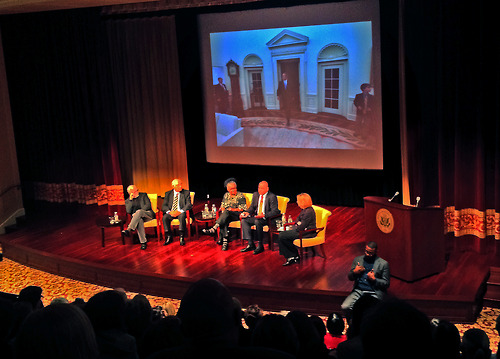
Former Clinton official photographer Sharon Farmer. (Photo by Dennis Brack)

(Photo by Dennis Brack)
Photographers who document are a breed to themselves. No one does it better than the official White House photographers. Last night at the National Archives in Washington, D.C. five of this elite group shared some stories. Each had a different way of doing their job. David Hume Kennerly provided a base with a history of the job and talked about the first and some say the best official photographer, Yoichi Okamoto,from the Lyndon B. Johnson administration. David also showed how his personal friendship with President Ford was valuable in maintaining the access that he needed to make his photographs. David Valdez was the only photographer on the panel who did not have a news background. His line, “What would Kennerly do?” was a great moment last night, but probably a real guideline for Valdez. His access was helped by having a great boss. President H. W. Bush. Sharon Farmer was a hoot!!! Sharon delighted the audience with her self depreciating humor and showed that she was the perfect match for President Clinton. Sharon also gave an example about something that was not brought up: The official photographer has to be unobtrusive most of the times, but he or she must be someone who you want to be around—a good traveling companion. The final photographer to speak was Eric Draper, a former Associated Press photographer who assigned to George W. Bush during his campaign. Eric was a news photographer and asked for the job. He got it and then covered the most important news assignment of his life—the behind the scenes story of President George W. Bush on 9/11 and the days that followed. The tight—to the point- photographs and Eric’s recollections are an important part of American History.
Dee Dee Myers, press secretary Clinton Administration, asked questions to the panel, but there was no time for questions from the audience. The discussion was being recorded and can be see at the National Archives UStream channel.

